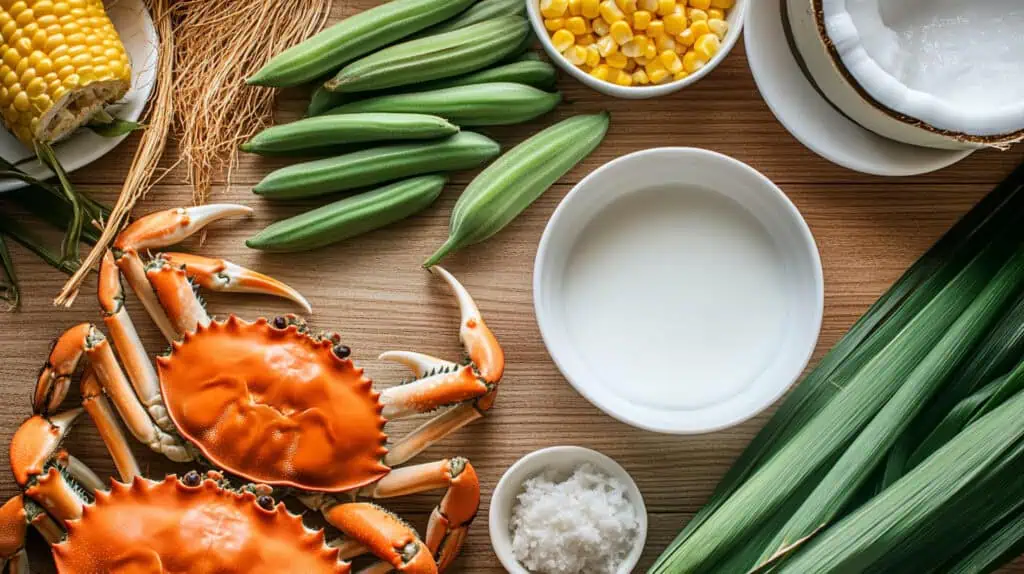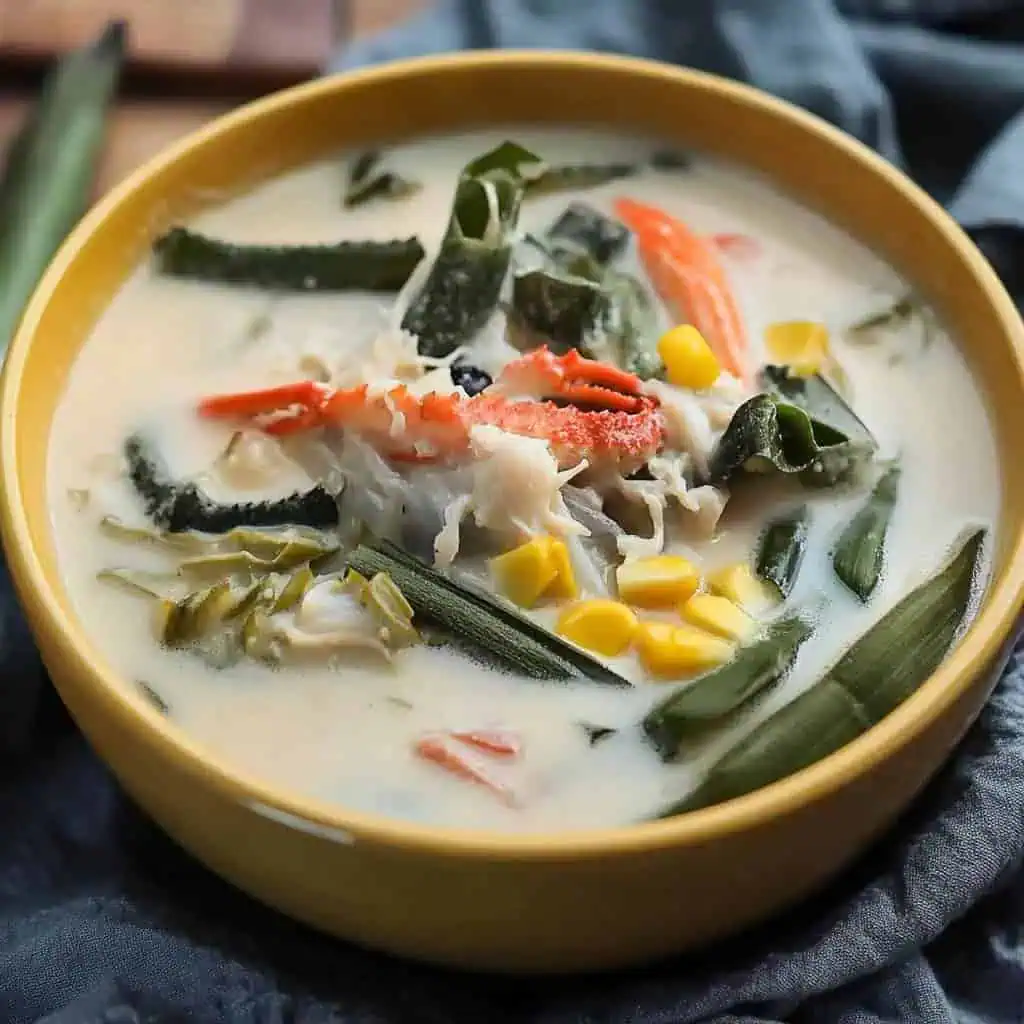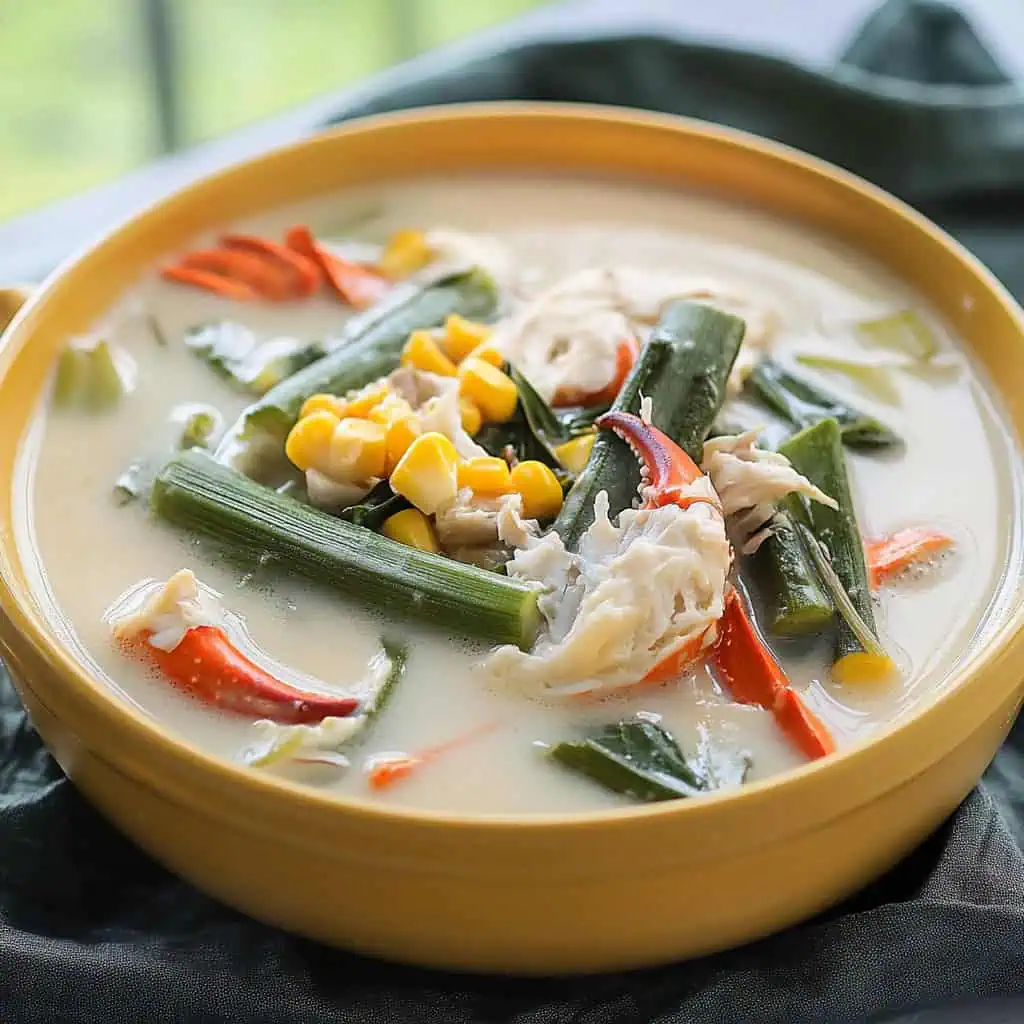During a trip to Iloilo, I stumbled upon Ginat-an nga Tambo while visiting my friend's aunt in their ancestral home. As I watched her skillfully prepare this dish in her tiny kitchen, surrounded by the aroma of coconut milk and the sizzle of garlic, she shared how this recipe had been passed down through generations of their family.
She showed me her secret: double-boiling the bamboo shoots to achieve that perfect tender-crisp texture. "Patience," she said with a knowing smile, "is what makes this dish special." Now every time I cook this creamy bamboo shoot and crab stew, I'm transported back to that warm afternoon in her kitchen, where I learned that the best Filipino dishes are made with both time and heart.
Jump to:

Why You'll Love This Recipe
- Authentic Filipino Comfort Food: Experience the genuine taste of Ilonggo cuisine with this traditional family recipe
- Perfect Balance of Flavors: Creamy coconut milk perfectly complements the fresh bamboo shoots and seafood
- Nutritious One-Pot Meal: Packed with vegetables, protein, and healthy fats
- Customizable: Easy to adjust spice levels and ingredients based on availability
- Budget-Friendly: Makes use of accessible ingredients while delivering restaurant-quality taste
Ingredients
This recipe combines bamboo shoots, crabs, and vegetables in coconut milk for authentic Ilonggo flavor. The bamboo shoots provide a tender-crisp texture and subtle earthy taste, while blue swimmer crabs add sweet, briny protein that balances the creaminess. Jute leaves and okra contribute thickness and nutritional value, while corn adds natural sweetness.
The Visayan shrimp paste delivers essential umami depth that can't be achieved with salt alone. Garlic forms the aromatic foundation, and when everything simmers in coconut milk, it creates a harmonious blend that showcases the natural bounty of both land and sea, a perfect representation of Filipino coastal cuisine.

- 600 g blue swimmer crabs
- 2 cups young bamboo shoots (tambo/labong), thinly sliced diagonally
- 1 stalk jute leaves (saluyot/tugabang)
- 400 g okra, sliced
- 1 cup fresh corn kernels
- 400 ml coconut milk
- 2 cups water
- 1 tablespoon Visayan shrimp paste (guinamos/bagoong)
- 4 cloves garlic, pounded
- Salt to taste
- Freshly ground black pepper to taste
Equipment
- Large pot (kaldero): For cooking the main dish, providing enough space for all ingredients to simmer properly in the coconut milk base.
- Medium Pot: For pre-boiling bamboo shoots, essential for removing their natural bitterness.
- Sharp knife (kutsilyo): For precise ingredient preparation, especially important for slicing bamboo shoots diagonally.
- Wooden spoon (sandok na kahoy): For gentle stirring without breaking ingredients, particularly important when working with coconut milk.
- Colander (salaan): For draining bamboo shoots after boiling, ensuring excess water is removed.
- Measuring cups and spoons (Panukat): For accurate portions, crucial for balancing flavors.
- Cutting board (Sangkalan): For safe ingredient preparation and protecting countertops.
- Mortar and pestle (dikdikan): For crushing garlic and spices to release maximum flavor.

How To Make
- Start by boiling the sliced bamboo shoots in a pot of water over high heat for 15 minutes until they become tender. Drain the water and squeeze out any excess moisture using your hands or a clean kitchen towel. Return the bamboo shoots to fresh water and boil again for 2 minutes to remove any remaining bitterness, then drain.
- In a large pot over medium heat, combine 2 cups of water and the prepared bamboo shoots. Bring this mixture to a gentle simmer. Add the sliced okra, corn kernels, coconut milk, and pounded garlic. Let everything simmer together for 10 minutes, stirring occasionally with a wooden spoon to prevent the coconut milk from curdling.
- Add the blue swimmer crabs and Visayan shrimp paste to the pot. Continue simmering for 5 minutes or until the crab shells turn bright orange-red and the meat becomes opaque. Gently add the jute leaves to the pot and allow them to wilt naturally in the hot liquid.
- Season the dish with salt and freshly ground black pepper according to your taste. Let it simmer for one final minute to allow the flavors to come together. Turn off the heat and let the dish rest for 2-3 minutes before serving.
- Serve hot in bowls with steamed white rice on the side. If desired, accompany with calamansi or lime wedges and fresh chilies for extra heat.

Tips from Lola's Kitchen
- Select the freshest ingredients: The quality of your bamboo shoots and crabs will significantly impact the final flavor. Look for young, pale bamboo shoots and lively, active crabs.
- Double-boil bamboo shoots properly: This is the most crucial step for eliminating bitterness. Don't rush this process - properly prepared bamboo shoots should be tender with no astringent taste.
- Add a pinch of sugar: A small amount (½ teaspoon) can balance flavors without making the dish sweet.
- Low and slow cooking: Keep heat at medium-low, especially after adding coconut milk, to prevent curdling and allow flavors to meld.
- Let it rest: Allow the dish to sit for 2-3 minutes after cooking for the best flavor development.
- Test bamboo shoots: Before adding to the main pot, taste a small piece to ensure all bitterness is gone.
- Use coconut cream for richness: For special occasions, substitute ¼ of the coconut milk with coconut cream for extra luxurious texture.
- Fresh-made shrimp paste: If possible, use freshly made guinamos rather than packaged versions for authentic flavor.
Substitutions
- Bamboo Shoots: Canned bamboo shoots work well (reduce initial boiling to 5 minutes). In a pinch, heart of palm or young jackfruit can provide similar texture.
- Blue Swimmer Crabs: Mud crabs, shrimp, or even firm white fish can replace the crabs.
- Jute Leaves: Spinach, malunggay (moringa) leaves, or watercress make good alternatives.
- Coconut Milk: Canned coconut milk works fine (reduce water by ¼ cup). For a lighter version, use light coconut milk.
- Guinamos: Regular bagoong alamang, fish sauce, or even miso paste can substitute for Visayan shrimp paste.
- Okra: Green beans or eggplant can replace okra for different texture but similar function.
- Corn Kernels: Skip entirely or replace with chopped carrots for sweetness.
Troubleshooting
Bitter Bamboo Shoots
- Issue: Despite boiling, bamboo shoots still taste bitter
- Solution: Return to boiling water with 2 tablespoons of rice grains for 10 more minutes, then drain and rinse well
- Prevention: Always choose young, pale shoots and double-boil as directed
Curdled Coconut Milk
- Issue: Coconut milk separates and looks grainy
- Solution: Lower heat immediately and whisk gently until recombined
- Prevention: Never allow mixture to boil after adding coconut milk, stir regularly, and keep heat low
Tough Crab Meat
- Issue: Crab meat is difficult to remove or tough to chew
- Solution: Extend cooking time by 3-5 minutes, checking frequently
- Prevention: Choose smaller, younger crabs and crack shells slightly before adding
Too Watery
- Issue: Final dish lacks thickness
- Solution: Simmer uncovered for 5-10 additional minutes
- Prevention: Ensure bamboo shoots are well-drained and squeeze out excess water
Too Salty
- Issue: Excessive saltiness from shrimp paste
- Solution: Add a peeled, cubed potato to absorb some salt, or dilute with additional coconut milk
- Prevention: Add shrimp paste gradually, tasting as you go
Storage & Reheating
Refrigeration:
- Store in an airtight glass container for up to 3 days
- Keep crab pieces separate from the broth if storing longer than a day
Freezing:
- Not generally recommended due to coconut milk content
- If necessary, freeze only the vegetable and broth portion without crabs
- Use within 1 month and expect texture changes
Reheating:
- Stovetop (Best Method): Place in pot with 2 tablespoons of fresh water, warm on low heat while stirring gently
- Microwave: Heat at 50% power in 1-minute intervals, stirring between each
- Always check seafood is thoroughly reheated to 165°F (74°C) before consuming
- Add a splash of fresh coconut milk after reheating to revive creaminess

FAQ
Can I use frozen bamboo shoots?
Yes, thaw completely and reduce initial boiling time to 10 minutes. The texture may be slightly softer than fresh bamboo shoots.
Why pre-boil bamboo shoots?
Bamboo shoots contain natural toxins and bitter compounds that must be removed through boiling. This process ensures both safety and pleasant flavor.
Is this dish spicy?
The traditional version is mild. Add Thai chilies or chili oil if you prefer heat. Start with 1-2 small chilies and adjust to your preference.
How do I prepare the crabs for this dish?
Clean crabs by removing the top shell, gills, and intestines. Cut body into quarters and crack claws slightly to allow flavor absorption.
Can I make this vegetarian?
Yes, omit crabs and shrimp paste, substitute with mushrooms and tofu, and use salt or vegetable bouillon for seasoning. Add 1 tablespoon soy sauce for umami.
What's the best type of coconut milk to use?
Fresh coconut milk is ideal, but canned full-fat coconut milk (not coconut cream or light versions) makes a good substitute. Avoid sweetened coconut milk products.
How can I tell if bamboo shoots are fresh?
Fresh bamboo shoots should feel heavy for their size, with firm texture and no discoloration. They should smell clean with no fermented or sour aroma.
Can I add other vegetables?
Yes, long beans, squash, or eggplant make excellent additions. Add firmer vegetables earlier in the cooking process and adjust cooking time accordingly.
Related
Looking for other recipes like this? Try these:

Ginat-an nga Tambo (Filipino Bamboo Shoots in Coconut Milk)
Equipment
- Large pot (kaldero) For cooking the main dish
- Medium Pot For pre-boiling bamboo shoots
- Sharp knife (kutsilyo) For precise ingredient preparation
- Wooden spoon (sandok na kahoy) For gentle stirring without breaking ingredients
- Colander (salaan) For draining bamboo shoots
- Measuring cups and spoons (Panukat) For accurate portions
- Cutting board (Sangkalan) For safe ingredient preparation
- Mortar and pestle (dikdikan) For crushing garlic and spices
Ingredients
- 600 g blue swimmer crabs
- 2 cups young bamboo shoots tambo/labong, thinly sliced diagonally
- 1 stalk jute leaves saluyot/tugabang
- 400 g okra okra, sliced
- 1 cup fresh corn kernels mais
- 400 ml coconut milk gata
- 2 cups water tubig
- 1 tablespoon Visayan shrimp paste guinamos/bagoong
- 4 cloves garlic bawang, pounded
- Salt asin
- Freshly ground black pepper paminta to taste
Instructions
- Start by boiling the sliced bamboo shoots in a pot of water over high heat for 15 minutes until they become tender. Drain the water and squeeze out any excess moisture using your hands or a clean kitchen towel. Return the bamboo shoots to fresh water and boil again for 2 minutes to remove any remaining bitterness, then drain.
- In a large pot over medium heat, combine 2 cups of water and the prepared bamboo shoots. Bring this mixture to a gentle simmer. Add the sliced okra, corn kernels, coconut milk, and pounded garlic. Let everything simmer together for 10 minutes, stirring occasionally with a wooden spoon to prevent the coconut milk from curdling.
- Add the blue swimmer crabs and Visayan shrimp paste to the pot. Continue simmering for 5 minutes or until the crab shells turn bright orange-red and the meat becomes opaque. Gently add the jute leaves to the pot and allow them to wilt naturally in the hot liquid.
- Season the dish with salt and freshly ground black pepper according to your taste. Let it simmer for one final minute to allow the flavors to come together. Turn off the heat and let the dish rest for 2-3 minutes before serving.
- Serve hot in bowls with steamed white rice on the side. If desired, accompany with calamansi or lime wedges and fresh chilies for extra heat.
Tips from Lola's Kitchen
- Choose young bamboo shoots for the best texture and flavor
- If using canned bamboo shoots, reduce initial boiling time to 5 minutes
- Test bamboo shoots for bitterness before adding to the main pot
- Don't overcook the jute leaves to maintain their texture
- Add coconut milk gradually to prevent curdling
- Season gradually and taste as you go
Nutrition
The Story Behind Ginat-an nga Tambo
Deep in the heart of the Visayas region, particularly in Iloilo province, Ginat-an nga Tambo emerged as a testament to the Ilonggo people's resourcefulness and culinary ingenuity. This beloved dish tells the story of how local communities made the most of nature's bounty, combining fresh bamboo shoots that grew abundantly in their highlands with the day's catch from nearby waters.
The name itself reveals its humble origins - "Ginat-an" refers to anything cooked in coconut milk, while "Tambo" is the local word for bamboo shoots. This cooking method dates back generations, when Ilonggo families would harvest young bamboo shoots during the rainy season, a time when they sprouted most prolifically. The addition of coconut milk, a staple in Filipino coastal communities, transformed these sometimes bitter shoots into a creamy, luxurious dish.
What makes this recipe particularly special is its evolution from a simple vegetable dish to a more elaborate creation. As fishing communities flourished along Iloilo's coast, fresh seafood - particularly blue swimmer crabs - became a natural addition to the dish. The briny sweetness of the crabs perfectly complemented the subtle earthiness of the bamboo shoots, while the coconut milk brought everything together in a harmonious blend.
Today, Ginat-an nga Tambo represents more than just a meal; it's a cultural touchstone that connects modern Filipino families to their agricultural and maritime heritage. In many Ilonggo households, the recipe is treasured and passed down through generations, each family adding their own subtle variations while maintaining the dish's essential character. Whether served during special occasions or as a comforting weekday meal, this dish continues to tell the story of Ilonggo cuisine's remarkable ability to transform simple ingredients into something extraordinary.
Modern interpretations of the dish might include different vegetables or seafood variations, but the core elements - the bamboo shoots, coconut milk, and the careful balance of flavors - remain unchanged, preserving the authentic taste that has made this recipe a beloved part of Filipino culinary heritage.










Comments
No Comments